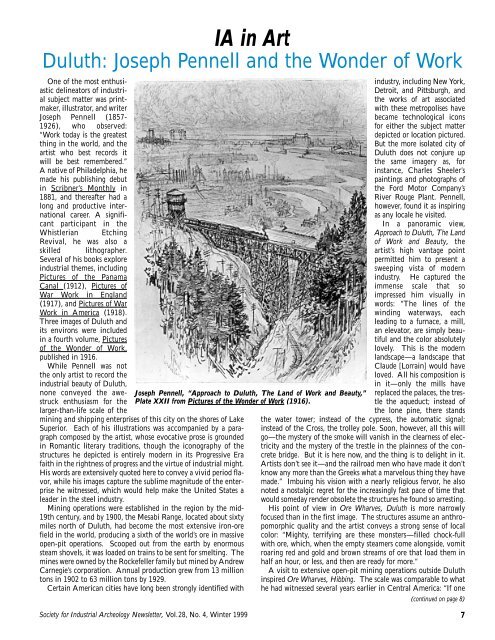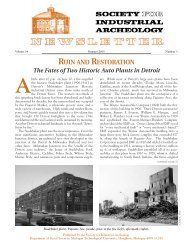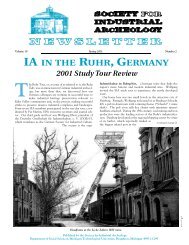birmingham, “pittsburgh of the south,” - Society for Industrial ...
birmingham, “pittsburgh of the south,” - Society for Industrial ...
birmingham, “pittsburgh of the south,” - Society for Industrial ...
You also want an ePaper? Increase the reach of your titles
YUMPU automatically turns print PDFs into web optimized ePapers that Google loves.
IA in Art<br />
Duluth: Joseph Pennell and <strong>the</strong> Wonder <strong>of</strong> Work<br />
One <strong>of</strong> <strong>the</strong> most enthusiastic<br />
delineators <strong>of</strong> industrial<br />
subject matter was printmaker,<br />
illustrator, and writer<br />
Joseph Pennell (1857-<br />
1926), who observed:<br />
“Work today is <strong>the</strong> greatest<br />
thing in <strong>the</strong> world, and <strong>the</strong><br />
artist who best records it<br />
will be best remembered.<strong>”</strong><br />
A native <strong>of</strong> Philadelphia, he<br />
made his publishing debut<br />
in Scribner’s Monthly in<br />
1881, and <strong>the</strong>reafter had a<br />
long and productive international<br />
career. A significant<br />
participant in <strong>the</strong><br />
Whistlerian Etching<br />
Revival, he was also a<br />
skilled lithographer.<br />
Several <strong>of</strong> his books explore<br />
industrial <strong>the</strong>mes, including<br />
Pictures <strong>of</strong> <strong>the</strong> Panama<br />
Canal (1912), Pictures <strong>of</strong><br />
War Work in England<br />
(1917), and Pictures <strong>of</strong> War<br />
Work in America (1918).<br />
Three images <strong>of</strong> Duluth and<br />
its environs were included<br />
in a fourth volume, Pictures<br />
<strong>of</strong> <strong>the</strong> Wonder <strong>of</strong> Work,<br />
published in 1916.<br />
While Pennell was not<br />
<strong>the</strong> only artist to record <strong>the</strong><br />
industrial beauty <strong>of</strong> Duluth,<br />
none conveyed <strong>the</strong> awestruck<br />
enthusiasm <strong>for</strong> <strong>the</strong><br />
larger-than-life scale <strong>of</strong> <strong>the</strong><br />
mining and shipping enterprises <strong>of</strong> this city on <strong>the</strong> shores <strong>of</strong> Lake<br />
Superior. Each <strong>of</strong> his illustrations was accompanied by a paragraph<br />
composed by <strong>the</strong> artist, whose evocative prose is grounded<br />
in Romantic literary traditions, though <strong>the</strong> iconography <strong>of</strong> <strong>the</strong><br />
structures he depicted is entirely modern in its Progressive Era<br />
faith in <strong>the</strong> rightness <strong>of</strong> progress and <strong>the</strong> virtue <strong>of</strong> industrial might.<br />
His words are extensively quoted here to convey a vivid period flavor,<br />
while his images capture <strong>the</strong> sublime magnitude <strong>of</strong> <strong>the</strong> enterprise<br />
he witnessed, which would help make <strong>the</strong> United States a<br />
leader in <strong>the</strong> steel industry.<br />
Mining operations were established in <strong>the</strong> region by <strong>the</strong> mid-<br />
19th century, and by 1900, <strong>the</strong> Mesabi Range, located about sixty<br />
miles north <strong>of</strong> Duluth, had become <strong>the</strong> most extensive iron-ore<br />
field in <strong>the</strong> world, producing a sixth <strong>of</strong> <strong>the</strong> world’s ore in massive<br />
open-pit operations. Scooped out from <strong>the</strong> earth by enormous<br />
steam shovels, it was loaded on trains to be sent <strong>for</strong> smelting. The<br />
mines were owned by <strong>the</strong> Rockefeller family but mined by Andrew<br />
Carnegie’s corporation. Annual production grew from 13 million<br />
tons in 1902 to 63 million tons by 1929.<br />
Certain American cities have long been strongly identified with<br />
<strong>Society</strong> <strong>for</strong> <strong>Industrial</strong> Archeology Newsletter, Vol.28, No. 4, Winter 1999<br />
industry, including New York,<br />
Detroit, and Pittsburgh, and<br />
<strong>the</strong> works <strong>of</strong> art associated<br />
with <strong>the</strong>se metropolises have<br />
became technological icons<br />
<strong>for</strong> ei<strong>the</strong>r <strong>the</strong> subject matter<br />
depicted or location pictured.<br />
But <strong>the</strong> more isolated city <strong>of</strong><br />
Duluth does not conjure up<br />
<strong>the</strong> same imagery as, <strong>for</strong><br />
instance, Charles Sheeler’s<br />
paintings and photographs <strong>of</strong><br />
<strong>the</strong> Ford Motor Company’s<br />
River Rouge Plant. Pennell,<br />
however, found it as inspiring<br />
as any locale he visited.<br />
In a panoramic view,<br />
Approach to Duluth, The Land<br />
<strong>of</strong> Work and Beauty, <strong>the</strong><br />
artist’s high vantage point<br />
permitted him to present a<br />
sweeping vista <strong>of</strong> modern<br />
industry. He captured <strong>the</strong><br />
immense scale that so<br />
impressed him visually in<br />
words: “The lines <strong>of</strong> <strong>the</strong><br />
winding waterways, each<br />
leading to a furnace, a mill,<br />
an elevator, are simply beautiful<br />
and <strong>the</strong> color absolutely<br />
lovely. This is <strong>the</strong> modern<br />
landscape—a landscape that<br />
Claude [Lorrain] would have<br />
loved. All his composition is<br />
in it—only <strong>the</strong> mills have<br />
replaced <strong>the</strong> palaces, <strong>the</strong> trestle<br />
<strong>the</strong> aqueduct; instead <strong>of</strong><br />
<strong>the</strong> lone pine, <strong>the</strong>re stands<br />
<strong>the</strong> water tower; instead <strong>of</strong> <strong>the</strong> cypress, <strong>the</strong> automatic signal;<br />
instead <strong>of</strong> <strong>the</strong> Cross, <strong>the</strong> trolley pole. Soon, however, all this will<br />
go—<strong>the</strong> mystery <strong>of</strong> <strong>the</strong> smoke will vanish in <strong>the</strong> clearness <strong>of</strong> electricity<br />
and <strong>the</strong> mystery <strong>of</strong> <strong>the</strong> trestle in <strong>the</strong> plainness <strong>of</strong> <strong>the</strong> concrete<br />
bridge. But it is here now, and <strong>the</strong> thing is to delight in it.<br />
Artists don’t see it—and <strong>the</strong> railroad men who have made it don’t<br />
know any more than <strong>the</strong> Greeks what a marvelous thing <strong>the</strong>y have<br />
made.<strong>”</strong> Imbuing his vision with a nearly religious fervor, he also<br />
noted a nostalgic regret <strong>for</strong> <strong>the</strong> increasingly fast pace <strong>of</strong> time that<br />
would someday render obsolete <strong>the</strong> structures he found so arresting.<br />
His point <strong>of</strong> view in Ore Wharves, Duluth is more narrowly<br />
focused than in <strong>the</strong> first image. The structures assume an anthropomorphic<br />
quality and <strong>the</strong> artist conveys a strong sense <strong>of</strong> local<br />
color: “Mighty, terrifying are <strong>the</strong>se monsters—filled chock-full<br />
with ore, which, when <strong>the</strong> empty steamers come alongside, vomit<br />
roaring red and gold and brown streams <strong>of</strong> ore that load <strong>the</strong>m in<br />
half an hour, or less, and <strong>the</strong>n are ready <strong>for</strong> more.“<br />
A visit to extensive open-pit mining operations outside Duluth<br />
inspired Ore Wharves, Hibbing. The scale was comparable to what<br />
he had witnessed several years earlier in Central America: “If one<br />
Joseph Pennell, “Approach to Duluth, The Land <strong>of</strong> Work and Beauty,<strong>”</strong><br />
Plate XXII from Pictures <strong>of</strong> <strong>the</strong> Wonder <strong>of</strong> Work (1916).<br />
(continued on page 8)<br />
7






